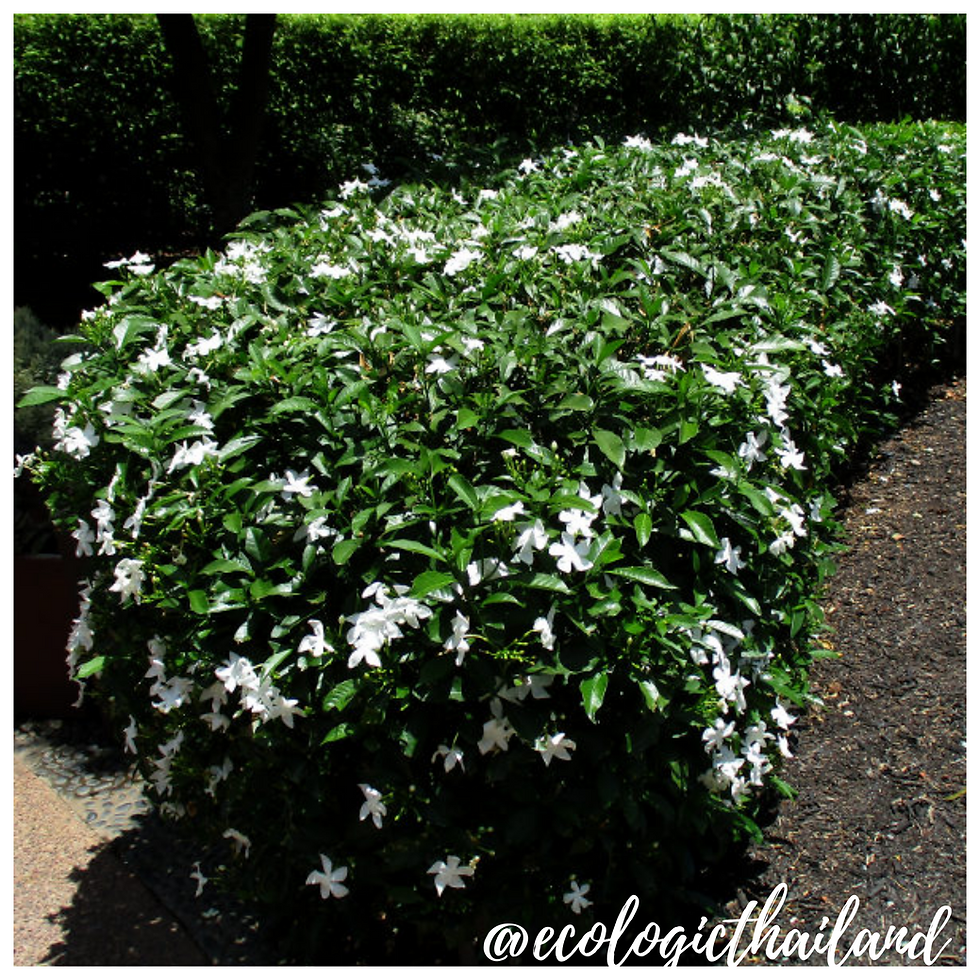Cacao tree
- Eco-Logic Resort
- Dec 8, 2020
- 4 min read
Thon Coco | ต้นโกโก้ | Theobroma cacao
Family: Malvaceae - Genus: Theobroma

You will find a number of cacao trees near the Natural Building project on the premises of Eco-Logic Thailand.
The cacao tree's botanical name is Theobroma Cacao, which means "food of the gods" in Greek. The cacao tree grows to be about 30 feet tall bearing white flowers and colorful fruit.
It takes a cacao tree about five years to produce its first fruit, otherwise known as a cacao pod.
The cacao pod has a hard shell, is shaped like a bloated cucumber, and is usually red, yellow, or orange. Cacao pods take 4-5 months to grow, several weeks to ripen, and are cut from the tree with a sharp blade.
The cacao tree will usually live to see its 100th birthday but only produces fruit for about half of its lifetime. Cacao trees love the shade and are often grown beneath other trees such as mango, banana, papaya, or rubber trees.
After four years the mature cacao tree produces fruit. Cacao can be harvested throughout the year, producing two crops. The larger, main crop is harvested in the dry season.

THE TREE
Cocoa is a spindly, evergreen tree 5 to 8 m tall, found growing in the shade of giant trees occupying the top layer of the rain forest. It has a taproot, which penetrates far below the soil surface.

THE LEAVES
The dark green leaves are shiny, leathery, egg-shaped or elliptic in shape and 20 to 35 cm long and 7 to 8 cm wide. The leaf surfaces are hairless or covered in scattered star-shaped hairs. The base of the leaf is rounded or heart-shaped, and the tip is long and drawn out allowing water to drip from it.

THE FLOWERS
The flowers are produced in clusters directly on the trunk and older branches; this is known as cauliflory. The flowers are small, 1–2 centimeter in diameter, with pink calyx. Cacao flowers are pollinated by tiny flies.

THE FRUIT
After four years the mature cacao tree produces fruit in the form of elongated pods; it may yield up to 70 such fruits annually.
In the wild, cocoa trees are pollinated by midges, and only about 5% of flowers receive enough pollen to start fruit development. When they are pollinated there is a dramatic change as the tiny flowers develop into massive fruits.
The fruit, called a cacao pod, is ovoid, 15–30 centimeter long and 8–10 centimeter wide, ripening yellow to orange, and weighs about 500 grams when ripe. The pod contains 20 to 60 seeds, usually called "beans", embedded in a white pulp. The seeds are the main ingredient of chocolate, while the pulp is used in some countries to prepare refreshing juice, smoothies, jelly, and cream. Each seed contains a significant amount of fat (40–50%) as cocoa butter. The fruit's active constituent is the stimulant theobromine, a compound similar to caffeine.
CULINARY USES
The dried, fermented and roasted seeds of the Cacao plant, the cacao beans, are the source of cocoa, chocolate and cocoa butter.
These are widely used in the confectionery industry to made chocolate confections, cakes, ice cream, drinks etc.
The somewhat bitter flavor is usually moderated by adding sugar or other sweetener. The seed contains up to 50% fat.
The ripe seeds are cured by pressing, fermenting and then drying them. The cured seeds are then roasted and ground into a powder to make cocoa.
A butter-like fat (called cocoa butter) is extracted from the seeds.
The fruit contains about 20 - 40 seeds surrounded by a thin, succulent pulp with a slightly sweet flavour. This pulp is sucked as a sweet snack. It can be made into juices and jellies.
The seed contains a pigment that is said to be useful as a food coloring.
At our Food Forest Kitchen Restaurant you will find several yummy chocolate options, like the chocolate cake, chocolate pudding and chocolate fudge. Click on the logo of the restaurant to find the recipes.
NUTRITION CACAO NIBS
Unlike many chocolate products, cacao nibs are naturally low in sugar. They're also a good source of fiber, protein, and healthy fats — nutrients that help promote feelings of fullness. They're rich in many minerals, including iron, magnesium, phosphorus, zinc, manganese, and copper.
TRADITIONAL MEDICINAL USE
NOTE: please take advice from a doctor if you are planning to use herbal medicine.
Long regarded as a food treat, cocoa is now used by some people as medicine. Cocoa seed is used for infectious intestinal diseases and diarrhea, asthma, bronchitis, and as an expectorant for lung congestion. The seed coat is used for liver, bladder, and kidney ailments; diabetes; as a tonic; and as a general remedy.
Cocoa butter is used for high cholesterol. Some people apply cocoa butter to the skin to treat wrinkles and to prevent stretch marks during pregnancy.
In manufacturing, cocoa butter is used as a base for various ointments and suppositories made by drug companies.
INTO THE WILD: a down to earth experience

For guests and visitors to Paksong we organize weekly tours "The Edible Forest" and Foraging weekends: Into the Wild. We work with local guides to take you in the jungle of Paksong. After foraging, we will cook a meal with the ingredients, using bamboo together with you!
Come and join and learn about the abundance of food that nature gives us!
INTO THE WILD!


















Comments